Knowledge is power
So let’s dive into learning about how herniated discs occur and practical ways to prevent and alleviate their impact. Let’s walk through the enticing world of spinal health, focusing on the unspoken significance of posture and introducing a series of easy-to-learn stretches that can contribute to a healthy spine.
Your spinal column is made up of 33 vertebrae that are connected to make it mobile by discs to serve as cushions for the spine. These discs are like “jelly donuts” with a thick outside and a jelly inside and that fluid and movement, when healthy, can be shock absorbers in the spine and prevent injury. Over time and with improper wear and tear the donut can compress and the jelly on the inside can leak into the outer layer of the donut. This is known as a bulging disc but if the jelly escapes the outer layer of the donut, it is known as a herniated disc. When a disc becomes herniated, it can exert pressure on adjacent nerves, resulting in pain, numbness, and diminished motor function.
Posture: The Backbone of Disc Health
One of the most influential contributors to the onset and progression of herniated discs is poor posture. Habits of slouching for long periods of time or maintaining incorrect spinal alignment place undue stress on the intervertebral discs, potentially exacerbating their vulnerability to herniation. Prioritizing proper posture and regular exercise throughout the workday can significantly mitigate this risk.
Introducing Science-Backed Stretches for Disc Health
Cat-Cow Stretch: This move from the Yogi masters of the world involves alternating between arching and rounding the back while on all fours. This motion serves to enhance spinal flexibility, providing a nurturing environment for the discs and reducing the likelihood of herniation.
Trunk Extension: A restful stretch where the hips are on the ground, and you extend both arms like a push-up slowly into trunk extension. By extending the spine, this exercise fosters circulation, flexibility, and disc nourishment. Hold for 30 seconds and if you experience pain, discontinue stretch.


Pelvic Tilt: Executed while lying on the back with knees bent, the pelvic tilt entails flattening the lower back against the floor by tilting the pelvis upwards. Activation of the core muscles assists in stabilizing the spine and preventing undue strain on the discs.
Bridging: Executed while lying on the back with knees bent, push up your hips to the sky and try to hold for 30 seconds. If you experience pain, discontinue exercise.
Hip Flexor Stretch: In the side-lying position, bend the knee of the top leg not on the ground Lying on the back with knees bent, the knees are gradually lowered to one side while the shoulders remain grounded. This twist bolsters spinal mobility, reducing rigidity and promoting disc health.
A Disciplined Approach to Spinal Well-Being
In addition to adopting a routine that involved stretching and regular exercises, cultivating mindful practices to reinforce proper posture cannot be overstated. The maintenance of an upright spinal alignment during daily activities, coupled with investing in a chair that supports healthy posture, will significantly contribute to the prevention and management of herniated discs.
Looking for an office chair for herniated discs, look no further than Anthros.
Anthros is the only chair in the world that is guaranteed to improve posture, or your money back. The science backed, patented design, is registered with the FDA as a posture improving chair and is proven to have the lowest pressure (most comfortable) cushion on the planet (verified by University testing).
Take the next step to reducing pain, increasing comfort and maximizing performance!
Recent Post

Four Lessons About Seating Everyone Can Learn from Wheelchair Users
September 18, 2025Working with wheelchair users has been an...

People Over Profits: Why Anthros Puts Comfort and Care First
September 17, 2025At Anthros, our mission is simple: to put people...










